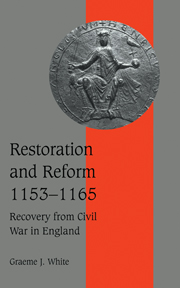Book contents
- Frontmatter
- Contents
- Preface
- List of abbreviations
- 1 The political context
- 2 The governance of England during Stephen's reign
- 3 Personnel and property
- 4 Financial recovery
- 5 The administration of justice
- 6 Conclusion
- Appendix I sheriffs' farms, 1130–65 and 1197
- Appendix II pipe roll, 11 Henry II (1164–5)
- Select bibliography
- Index
- Cambridge Studies in Medieval Life and Thought Fourth series
3 - Personnel and property
Published online by Cambridge University Press: 03 September 2009
- Frontmatter
- Contents
- Preface
- List of abbreviations
- 1 The political context
- 2 The governance of England during Stephen's reign
- 3 Personnel and property
- 4 Financial recovery
- 5 The administration of justice
- 6 Conclusion
- Appendix I sheriffs' farms, 1130–65 and 1197
- Appendix II pipe roll, 11 Henry II (1164–5)
- Select bibliography
- Index
- Cambridge Studies in Medieval Life and Thought Fourth series
Summary
INTRODUCTION
Henry II was conscious from the outset of his reign of the importance of upholding and enhancing the dignity of kingship. Although his first Easter court had been a glamorous affair, Stephen had often been too self-effacing: he ‘commonly forgot a king's exalted rank’ and ‘saw himself not superior to his men, but in every way their equal, sometimes actually their inferior’. Henry II, who was eventually to declare himself king ‘by the grace of God’, was concerned to present a different image: the repeated crown-wearings of the early years of the reign and the pressure he applied on Pope Alexander III to secure the canonisation of Edward the Confessor were intended to add lustre to his kingship. In subsequent years, he was at pains to keep his heir, Henry the Younger, above and apart from the baronial hierarchy – resisting demands to grant him a portion of his inheritance in his lifetime and refusing his homage ‘quia rex erat’. But effective kingship needed more than dignity. The goodwill, and active support, of Church leaders and of a fair proportion of the baronage – especially the richest among them, the magnates – was essential. So was loyal and efficient service by administrative officials. Both could be facilitated by patronage: indeed, decisions on who should receive patronage and from whom it should be withheld were among the most delicate facing any medieval king.
- Type
- Chapter
- Information
- Restoration and Reform, 1153–1165Recovery from Civil War in England, pp. 77 - 129Publisher: Cambridge University PressPrint publication year: 2000



